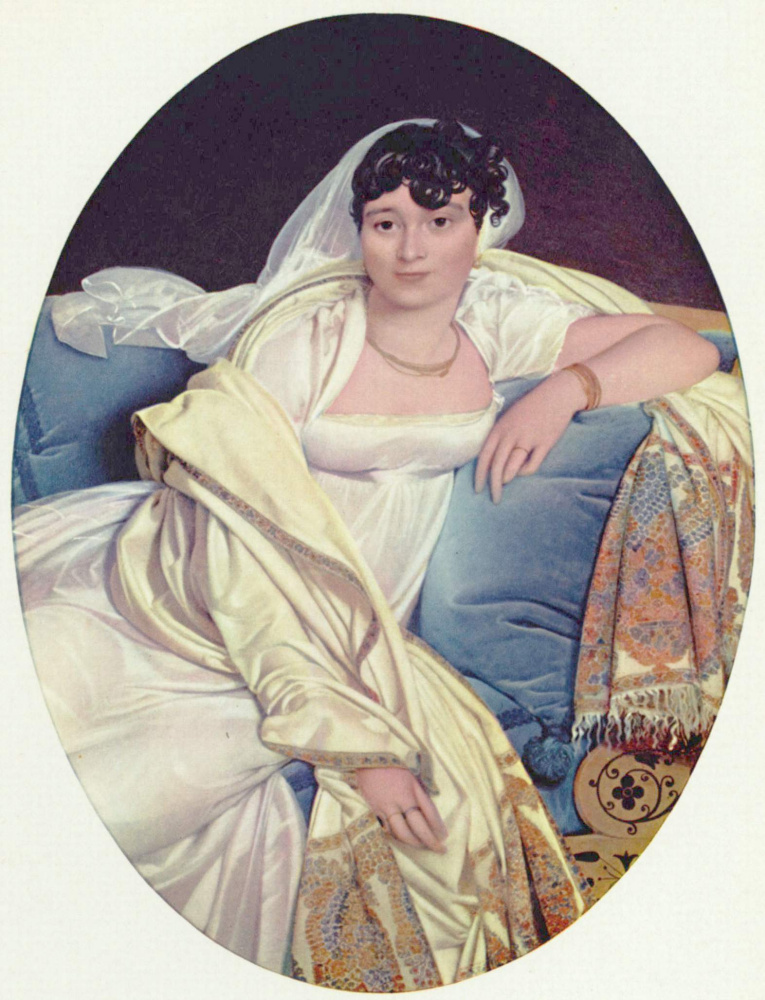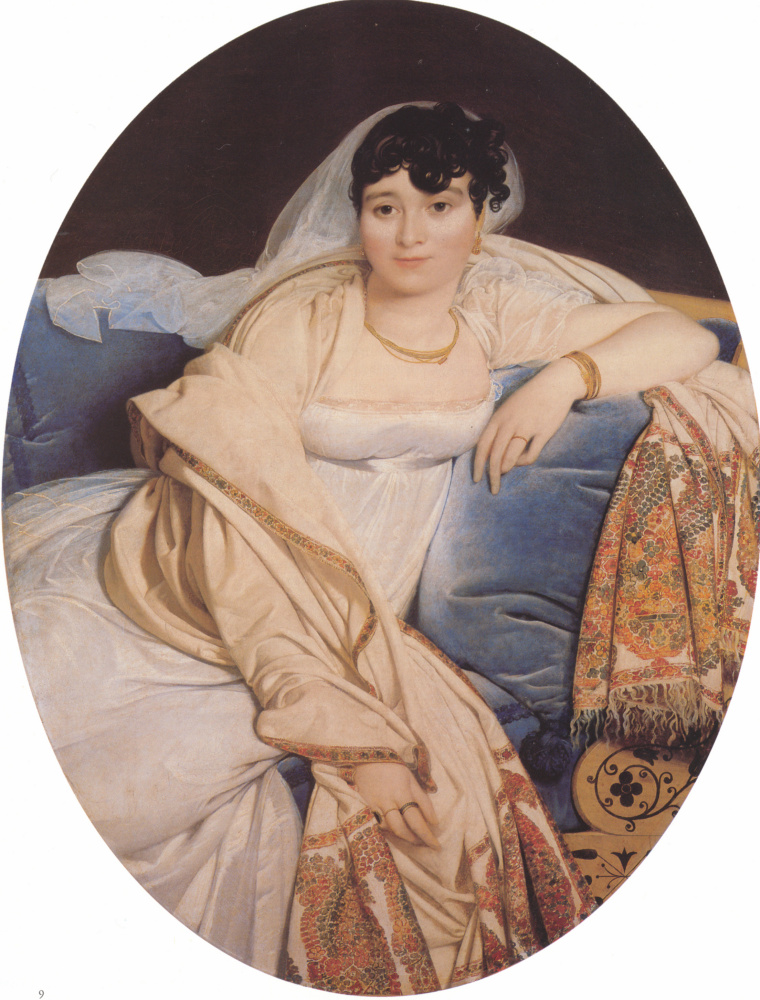log in
Enter site
Login to use Arthive functionality to the maximum
Portrait of Madame Riviere, née Marie Françoise Bibin Bloe de Beauregard
Jean Auguste Dominique Ingres • Painting, 1806, 116×81 cm
Description of the artwork «Portrait of Madame Riviere, née Marie Françoise Bibin Bloe de Beauregard»
"Portrait of Madame Riviere" - one of the cycle of images of the Riviera by Ingres. In fact, the painting of portraits was considered by the maestro, let's say, a hack: money has to be earned with something. Obviously, the customers of his work in this genre rated him higher than himself. And Baudelaire generally believed that Ingres - "The only person in France who can truly paint portraits".
All three portraits of the family Riviere Ingres exhibited at the Salon in 1806, and the public received them very cool. "They're somehow strange", - the audience and critics whispered, and went home.
First, the royal councilor Philibert Riviere ordered your portrait... This picture is large enough, in it obvious influenceschool teacher Ingres - Jacques-Louis David. An expressive figure on a neutral background, a rhythmic combination of vertical and horizontal lines give stability and solidity to the picture.
How different from this confident and even harsh portrait of Madame Riviere! Wavy lines, soft roundness, delicate sensuality - with this mood it was written. Ingres chose an oval shape, which made it possible to emphasize the softness and smoothness of female curves. The artist was blamed for anatomical discrepancies. In this case, Marie's chest is too high. This is not the only case when Ingres was accused of "incorrect" portrayal of the female body. Wits were ironic about located on the neck of Angelica's third breast, and "Big Odalisque"there were extra vertebrae.
Not without traditional complaints about hands without bones. Madame Rivière's fingers do look so soft as if they had no bones. Such a reproach is also true in relation to "Jupiter and Thetis", Where the hands of Thetis are clearly arranged according to other laws than those familiar to us.
However, this is not an anatomical atlas! Too high chest of Marie Riviere fits perfectly into the lightest, airy diagonal: from the upper right corner to the lower left - a rounded elbow, a relaxed hand, an Empire-style dress intercepted under the bust, leaving a soft wave over the edge of the canvas. The counterweight that creates the rhythmic play is a heavy silk shawl, the ends of which fall down from the left elbow, wrap around the right hand and slide off it. Above, the balance of lines and directions is created by the lightest gas cape thrown to the left and back, and curls of hair hanging down and to the right. Softness, tenderness and hidden sensuality - such is the mood of the portrait of Madame Riviere.
The third family portrait shows young mademoiselle Riviere... We see her against the background of a transparent spring landscape. Ingres' priorities are already evident in this portrait: he is moving further and further from his direct teacher David in the direction of the only idol - Raphael... Ingres generally believed that after Raphael, world painting took the wrong path, and this can only be corrected by returning to Raphael and continuing his line.
In the appearance of Carolina Riviere, everything is also not in order from the point of view of anatomy: again the chest is too high (but the graceful neck is perfection itself). Ingres was also reproached for the fact that gloved hands seem too huge for the fragile figure of a girl. At the same time, high small breasts, a snow-white dress with a boa and even contrastingly looking oversized hands in “heavy” soft light brown gloves emphasize the youth, innocence and airiness of the image as a whole. Smoothly combed hair, clear features, fresh blush and a very beautiful neck set off the brightness of the image and partially blur the background. The pose in which the girl is captured seems somewhat constrained, tense, which is quite natural - teenage girls, as a rule, feel angular and tense too much, it seems that this does not depend on the century. With age, a woman gets every chance to get rid of such tension - Madame Riviere in the portrait is absolutely relaxed. But Carolina did not manage to live up to this, the next year after painting the portrait, she died, forever remaining 13 years old.
Author: Alain Esaulova
All three portraits of the family Riviere Ingres exhibited at the Salon in 1806, and the public received them very cool. "They're somehow strange", - the audience and critics whispered, and went home.
First, the royal councilor Philibert Riviere ordered your portrait... This picture is large enough, in it obvious influenceschool teacher Ingres - Jacques-Louis David. An expressive figure on a neutral background, a rhythmic combination of vertical and horizontal lines give stability and solidity to the picture.
How different from this confident and even harsh portrait of Madame Riviere! Wavy lines, soft roundness, delicate sensuality - with this mood it was written. Ingres chose an oval shape, which made it possible to emphasize the softness and smoothness of female curves. The artist was blamed for anatomical discrepancies. In this case, Marie's chest is too high. This is not the only case when Ingres was accused of "incorrect" portrayal of the female body. Wits were ironic about located on the neck of Angelica's third breast, and "Big Odalisque"there were extra vertebrae.
Not without traditional complaints about hands without bones. Madame Rivière's fingers do look so soft as if they had no bones. Such a reproach is also true in relation to "Jupiter and Thetis", Where the hands of Thetis are clearly arranged according to other laws than those familiar to us.
However, this is not an anatomical atlas! Too high chest of Marie Riviere fits perfectly into the lightest, airy diagonal: from the upper right corner to the lower left - a rounded elbow, a relaxed hand, an Empire-style dress intercepted under the bust, leaving a soft wave over the edge of the canvas. The counterweight that creates the rhythmic play is a heavy silk shawl, the ends of which fall down from the left elbow, wrap around the right hand and slide off it. Above, the balance of lines and directions is created by the lightest gas cape thrown to the left and back, and curls of hair hanging down and to the right. Softness, tenderness and hidden sensuality - such is the mood of the portrait of Madame Riviere.
The third family portrait shows young mademoiselle Riviere... We see her against the background of a transparent spring landscape. Ingres' priorities are already evident in this portrait: he is moving further and further from his direct teacher David in the direction of the only idol - Raphael... Ingres generally believed that after Raphael, world painting took the wrong path, and this can only be corrected by returning to Raphael and continuing his line.
In the appearance of Carolina Riviere, everything is also not in order from the point of view of anatomy: again the chest is too high (but the graceful neck is perfection itself). Ingres was also reproached for the fact that gloved hands seem too huge for the fragile figure of a girl. At the same time, high small breasts, a snow-white dress with a boa and even contrastingly looking oversized hands in “heavy” soft light brown gloves emphasize the youth, innocence and airiness of the image as a whole. Smoothly combed hair, clear features, fresh blush and a very beautiful neck set off the brightness of the image and partially blur the background. The pose in which the girl is captured seems somewhat constrained, tense, which is quite natural - teenage girls, as a rule, feel angular and tense too much, it seems that this does not depend on the century. With age, a woman gets every chance to get rid of such tension - Madame Riviere in the portrait is absolutely relaxed. But Carolina did not manage to live up to this, the next year after painting the portrait, she died, forever remaining 13 years old.
Author: Alain Esaulova



